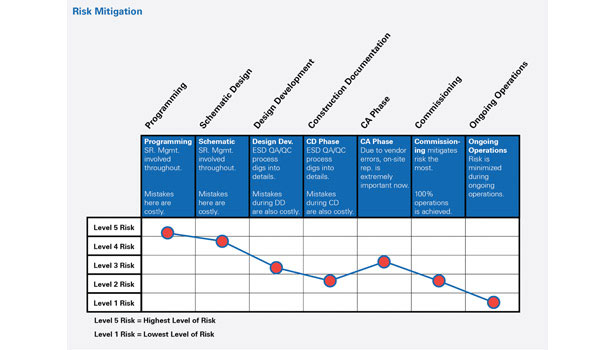PART 1: DEVELOPING THE PROGRAM
Over the next year, within each issue, I will be addressing the six steps required to getting to a total cost of ownership (TCO) when building or selecting a new data center. In most cases, a company will need to review the overall cost of building their new data center, then compare it to renting a wholesale or colocation data center. When comparing the build cost vs. wholesale cost, there are six major steps involved: developing the program, site surveys, planning, site selection, cost comparisons, and business justification documentation to be created for the board of directors or capital investors.
In 2011, Digital Realty Trust retained Campos Research to conduct a survey within the data center industry. One of the questions within the survey asked, “What are your reasons for data center expansion?” Over 76% of the responses focused on four primary reasons for data center expansion:
• Power
• Security
• Efficiency (PUE)
• Virtualization
While each one is a concern, it typically takes a combination of two of the above to generate a business case for data center expansion.
DEVELOPING THE TEAM
During the site selection and technical program stages of the TCO, it is important to bring in technical consultants and a brokerage firm to develop the overall criteria of the new data center. The technical team will assist in the creation of the program documents (owner’s requirements), and the brokerage firm will provide valuable information on the colocation/wholesale providers and develop requests for proposals.
PROGRAM INTERVIEWS
During programming, the technical consultants will conduct interviews with the client team, which typically includes both IT and facilities. The goal of the program interview process is to develop the new design criteria for the proposed data center. While several of the design criteria are similar in nature, every client’s program is different based upon their needs. Listed below are some of the key items to be addressed during the program interview process.
Growth rate. The technical consultant will work with the client to identify past and future growth of the data center. Typically, most companies have been growing at a 6% to 8% annual rate. This, too, differs from company to company, especially if they are in a mergers and acquisitions mode. Moving forward, the growth rate will need to be compounded annually, creating the ultimate design load and day one move-in load. This becomes the basis of the ultimate size of the data center including power requirements.
MEP infrastructure requirements. Once the ultimate power requirements have been determined, the design criteria for the MEP infrastructure can be outlined. Over the years, reliability has been the leading factor in designing data centers. While still true today, other factors such as power usage effectiveness (PUE), concurrently maintainable support systems, operating cost, and first cost vs. life-cycle cost are extremely important to address. Since electrical power is one of the highest operations cost (OPX), reducing the PUE will have a direct impact on TCO.
Refreshing technology. More and more companies veer from relocating existing servers from one data center to another. In most cases, new servers are purchased and installed in the new data center and cut over processing via a network switch. In addition, this is an opportune time to evaluate the use of virtualization within the new data center. The technology selected will drive the cabinet count and physical size of the new data center. While most companies are still processing at around 2.8 kW/rack, the typical design criteria has been 7 kW/rack with the capability to grow to 12 to 15 kW/rack. Through virtualization, we have designed as high as 30 kW/rack (not including an HPC environment). Therefore, it is very important to outline new processing requirements moving forward.
Scope, schedule, and budget. Now that we have identified growth, the MEP infrastructure criteria, and technology to be incorporated into the new data center, the technical consultant can create the overall prototype model of the data center that will be built or leased. This will include square footage based upon your new rack count, electrical and mechanical equipment schemes and risers, and the logical and physical network topology of the new data center. Once complete, the technical consultant can then develop line item costs for the interior build-out. This will be adjusted in step four of the TCO to reflect shell and core costs and other items, such as utility costs, that need to be incorporated into the final budget. Typically, the schedule to build out a 1MW data center is approximately 10 months from programming. Other scheduling issues that need to be addressed include leasing timeframe, long lead purchase of MEP equipment, and permitting issues.
Warning. During the program stage, items identified are considered “high-level” processes and strategies. We have found that if the high-level strategy is incorrect during the programming stage, the ramifications are much greater in cost later on. For example, if we determine that the ultimate growth is 1MW and in three years we reach over 1MW, the cost ramifications are far more significant expanding the data center than planning for additional growth earlier during the programming process.
FINAL PROGRAM REPORT
Upon conducting the interviews consisting of the topics above, the technical consultant can then bring all information into a cohesive program identifying the overall project criteria, milestones, and general cost of the relocation. This program becomes the basis of comparing new requirements to the existing data center. In addition, the program will be identified within the RFP for wholesale/collocation providers.
Part 2. In the next issue, I will be addressing the “Site Survey Process” and comparisons of existing conditions to the new program developed in Part 1. Some of the items to be discussed include identifying single points of failure within the MEP existing infrastructure, equipment aging, risk assessments, and examining existing operation costs.


